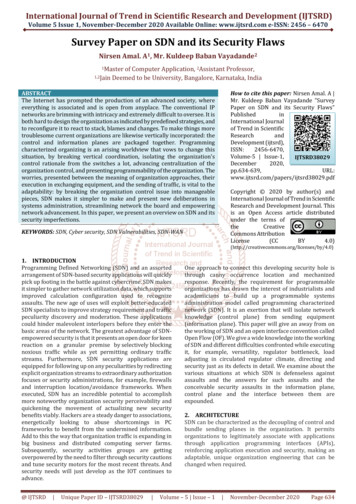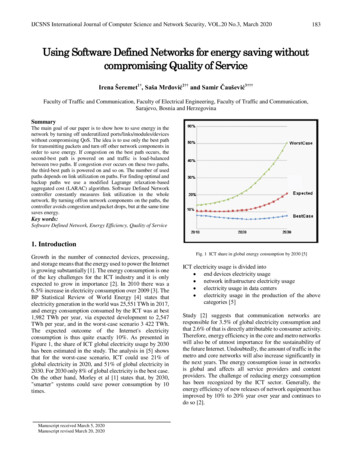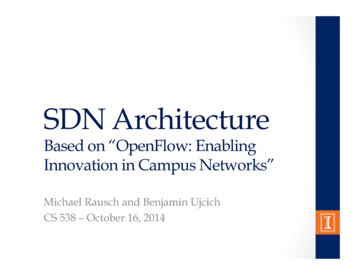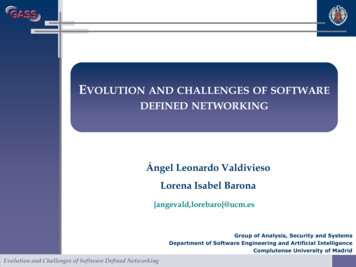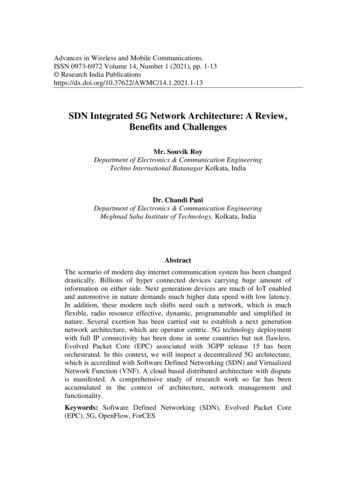
Transcription
Suneth Namal , Ijaz Ahmad†, Andrei Gurtov‡ and Mika Ylianttila§ †§Department of Communications, University of Oulu, Finland‡Department of Computer Science and Engineering, Aalto University, FinlandEmail: [ ka.ylianttila@oulu.fi
Overeview 18.11.2013AbstractMotivationIntroducing load balancing in EPCConceptual differencesSoftware Defined Networking (SDN)SDN based load balancingSimulation modelResult and analysisConclusionCWC Centre For Wireless Communications2
AbstractBy means of the highly flexible interfaces, SDN is simply effective in the5G network architecture where load balancing and dynamic flowadmission control are considered as essence of networking. In onehand, load balancing presented in this paper reveals a drastic reductionof unsatisfied-user percentage almost by five times while, on theother hand, it enhances per-flow resource allocation more than200%. In addition, this proposal substantially off-loads the core-network,avoids over-utilizing the cellular-network and reserves resources based oncut-off priority. Explicitly, it allows a certain degree of freedom tochoose the network options based on user-preference and theirpriorities.02.02.201118.11.2013For MEVICO internal useCWC Centre For Wireless Communications3
Motivation A typical load balancing configuration consists of multipleservers behind a load-balancer which would determinewhich server would service a client’s request. Such hardware is expensive, has a rigid policy set, andis a single point of failure. Load balancing in computer networks is a technique usedto spread workload across multiple network links orcomputers. This helps improve performance by optimallyusing available resources and helps in minimizing latencyand response time and maximizing throughput. SDN and the concept of programmability are trending likecrazy, and with that has come a new obsession withapplication programming interfaces (APIs) The ability to customize network devices and functionswith your own software.02.02.201118.11.2013For MEVICO internal useCWC Centre For Wireless Communications4
Introducing load balancing in EPC Load balancing is the technique of distributing the workload amongmultiple entities such as network links, CPUs, disk drivers or anyother kind of resources. The ultimate goal of load balancing is to achieve maximumthroughput, optimal resource utilization, avoid overloading andminimize response time. The effective use of load enablesextra benefit of reliability throughredundancy. The most common application ofload balancing is providing Internetservice from multiple servers thatare know as “server farm”. Load balancing allows to transferusers between the base stations inorder to maintain the appropriateend-user experiance and networkperformance.02.02.201118.11.2013For MEVICO internal useCWC Centre For Wireless Communications5
Conceptual differences Beyond the load balancing among multiple servers. Overall network status are counted Load status on base stations Expected waiting delay on each base stationUser preference as an essense infuture communication networks02.02.201118.11.2013For MEVICO internal useCWC Centre For Wireless Communications6
Software Defined Networking(SDN) SDNs separate the network control plane from the forwarding plane andhence separate the infrastructure from the architecture.Networks are simplified and can be (re)programmed without the need ofindividual network node configurations. The concepts of SDNs broadly revolve around i) alogically centralized controller having global view ofthe network e.g. a server, ii) the forwardingelements used to forward the traffic flows based onthe instructions from the controller e.g. andnetworkapplications (northbound communication). OpenFlow is the first viable enablerimplementation architecture of SDNs.18.11.2013andanCWC Centre For Wireless Communications7
SDN Based Load Balancing The logically centralized SDN architecture helps load balancing 18.11.2013utilize the global view of the network and take load balancingdecisions based on the load status of the entire networkcomponentsThe load balancing algorithm is implemented on top of thecontroller as an application (Application Layer)The load status of the network components is retrived by thecontroller via the southbound API to the load balancing Aplicationvia the northbound API.The load balancing decisions of the algorithm are then deployedin the network by the controller.Hence, global visibility of the status of network components isutilized to reliquish load imbalance in networks viaprogrammability attained in SDNs.CWC Centre For Wireless Communications8
SIMULATION MODEL : Flow of Load Balancing AlgorithmFig. 1. Load-balancing algorithm. unsatisfied users - The unsatisfied users could be defined as those who donot have obtained the expected flow space but theminimum allowable flow capacity per flow. angry users The angry users are those who do not get access totheir traffic flows due to lack of resources.02.02.201118.11.2013For MEVICO internal useCWC Centre For Wireless Communications9
Results and analysisFig. 2Fig. 3Fig. 2. Unsatisfied-user percentage: with increasing flow/user-intensity, flows wouldnot acquire the capacity that they demanded, thus, allocate the minimum affordableflow space.Fig. 3. Average resource allocation per-flow: while increasing flow intensity, a drasticreduction of allocated flow space is noticed. Our algorithm attempts to enhance perflow space by transferring and carefully admitting new flows.02.02.201118.11.2013For MEVICO internal useCWC Centre For Wireless Communications10
Results and analysisFig. 4.Fig. 4. Angry-user percentage: Even with load balancing, after some point,network can not offer resources to new & transferring flows due to mobility.02.02.201118.11.2013For MEVICO internal useCWC Centre For Wireless Communications11
Conclusion Seamless connectivity enabled with SDN is the bottom-line of this workwhich ultimately offloads core network, maximizes the per-flow capacity,and enhances the end-user experience by means of reduced waiting timeand drop-rate. Most strikingly, the results revealed that probabilistic approach hasreduced unsatisfied-user percentage almost by five times.Our model reveals a 237% of improvement in terms of per-flow resourceallocation.Furthermore, we have noticed a drastic reduction of drop-rate (300%)compared to the analytical model and almost 520% of reduction comparedto no load-balancing.Overall, our findings in this paper have elaborated the ultimate gain ofload balancing in the SDN context and verified the results based on ananalytical model. 02.02.201118.11.2013For MEVICO internal useCWC Centre For Wireless Communications12
02.02.201118.11.2013For MEVICO internal useCWC Centre For Wireless Communications13
The load balancing algorithm is implemented on top of the controller as an application (Application Layer) The load status of the network components is retrived by the controller via the southbound API to the load balancing Aplication via the northbound API. The load balancing decisions of the algorithm are then deployed in the network by the .

